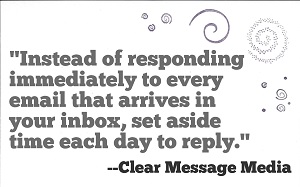By Jennifer Henderson
 I was complaining to Carole the other day about a woman who didn’t respond to my email. The woman had initially agreed to help me out with an interview I had wanted to conduct. After sending her two emails and getting no response, I gave up. I wasn’t sure whether the unanswered email meant that she didn’t want to work with me, that she was too busy to respond, or that the email went to her spam folder.
I was complaining to Carole the other day about a woman who didn’t respond to my email. The woman had initially agreed to help me out with an interview I had wanted to conduct. After sending her two emails and getting no response, I gave up. I wasn’t sure whether the unanswered email meant that she didn’t want to work with me, that she was too busy to respond, or that the email went to her spam folder.
In any case, Carole and I decided that unanswered emails seem to be on the rise. When email first came out, it didn’t have to compete with other social media tools. But, with the abundance of information we now receive from social media, we may have become so busy that we can’t respond to it all. With social media platforms like Facebook and Twitter, you can pick and choose what to respond to and what to ignore. The same “pick and choose” mentality may have trickled down to email.
A recent article in The New York Times lists other reasons, as well. A reporter for the paper polled her friends and found that limited time and too many emails are the most common reasons people don’t respond. In addition, many people delay or avoid writing back because they don’t want to say no. “We’ve seen an increase in the nonresponse rather than just politely declining,” digital marketing consultant Adam Boettiger told the reporter. “You delete it and hope it goes away, just like if someone comes to your door and you pretend you’re not home.”
Send email that gets a response
No matter what someone’s reason for not responding to an email, it can hurt or delay business if you don’t hear back, especially on something that is time-sensitive. As Carole mentioned in a previous post, “Email is still how business runs.”To help increase your chance of writing an email that garners a response, the website Lifehacker offers a few tips.
First, timing is important. According to a survey by email marketing firm GetResponse, most emails arrive in the inbox in the morning. Therefore, emails sent in the afternoon have a greater chance of being opened and clicked on. Lifehacker says that emails should be sent when you know the person is least busy, if possible.
In addition, Lifehacker says if you want a reply, ask for it. At the end of the email say, for example, “Please let me know what you think” or “I need to hear back on this, please respond.”
It might also help to give the person a deadline to respond. I always like to say something like, “If I don’t hear back from you, I’ll assume that [whatever I asked for] is ok.” This is especially useful if you want someone to review something you’ve written. For example, “If I don’t hear back from you by Tuesday at 5:00 pm, I’ll assume that xxx is acceptable.”
Also, don’t forget about good grammar, spelling, and punctuation, which indicate you took the time to craft your message. I know I’m more likely to respond to an email when it’s clear the sender cared about its content.
Don’t have unanswered emails in your inbox
On the flip side, try not to ignore emails yourself. When you don’t know what to write, step away from the computer and return to the message later, as we mention in a previous blog post about overcoming writer’s block.
An article on About.com suggests that instead of responding immediately to every email that arrives in your inbox, set aside time each day to reply. You can check your inbox periodically for any emails requiring urgent action (or filter them into a “needs response” folder), but turn off automatic mail checking and new mail announcements, which can be distracting.
In addition, the article says to respond to the easiest emails first. “Once you get to the more challenging emails, the steady progress has tamed them a bit already,” the article states.
Have you found that people don’t respond to email like they once did? If so, what tactics do you use to get responses? And what strategies help you keep on top of your email correspondence?


[…] a previous blog post, I talked about the importance of scheduling time to respond to e-mails. The same goes for […]